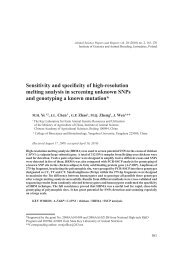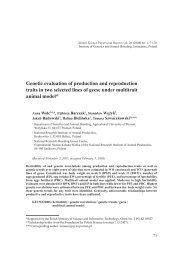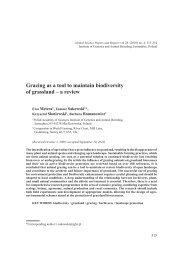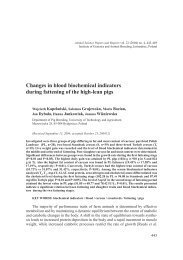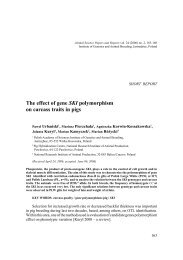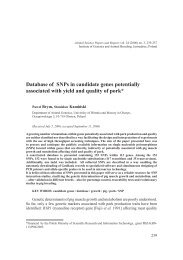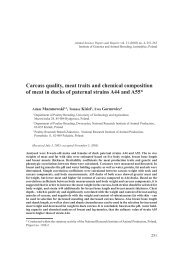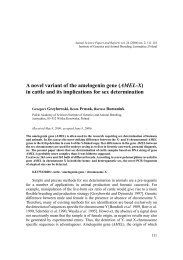Preliminary observations on the Echinacea-induced lactoferrin ...
Preliminary observations on the Echinacea-induced lactoferrin ...
Preliminary observations on the Echinacea-induced lactoferrin ...
You also want an ePaper? Increase the reach of your titles
YUMPU automatically turns print PDFs into web optimized ePapers that Google loves.
<strong>Echinacea</strong>-<strong>induced</strong> <strong>lactoferrin</strong> producti<strong>on</strong> in goat milk<br />
The experiment was carried out at <strong>the</strong> Polish Academy of Sciences Institute of<br />
Genetics and Animal Breeding, Jastrzębiec, <strong>on</strong> Polish White Improved (upgraded)<br />
goats. Out of a flock of 30, 10 animals in <strong>the</strong> initial stages of lactati<strong>on</strong> were chosen<br />
with <strong>the</strong> highest somatic cell count (SCC) of milk. During <strong>the</strong> experiment, all animals<br />
were kept in pens, and fed indoors. The diet was composed of 1.2 kg of c<strong>on</strong>centrates,<br />
2.5-3.0 kg of haylage and 1 kg hay. Echinapur pills (Herbapol, Poland), c<strong>on</strong>taining<br />
<strong>Echinacea</strong> purpurea extract were given over two weeks in starch capsules, twice daily,<br />
during milking. The daily dose of Echinapur applied was suitable for an adult man,<br />
i.e. 6 pills, each c<strong>on</strong>taining 100 mg of extract, being equal to 2 mg active substance<br />
(polyphenol acids) per pill. The effectiveness of Echinapur was established <strong>on</strong> <strong>the</strong> basis<br />
of its effect <strong>on</strong> <strong>the</strong> SCC/cm 3 milk, total number of milk bacteria, expressed as col<strong>on</strong>y<br />
forming units (CFU/cm 3 ), and <strong>lactoferrin</strong> (Lf) c<strong>on</strong>tent of milk.<br />
The SCC, CFU and Lf c<strong>on</strong>tent were determined in milk samples taken four times:<br />
before <strong>the</strong> start of treatment (initial level), immediately after administrati<strong>on</strong> <strong>the</strong> last<br />
dose (final level), and <strong>the</strong>n two and four weeks after terminati<strong>on</strong> of <strong>the</strong> treatment. Milk<br />
samples were subjected to routine analysis for protein, fat, lactose and dry matter using<br />
Milkoscan FT 120 (Foss Electric). The SCCs were determined with <strong>the</strong> Somacount<br />
150 (Bentley) and CFUs using spiral inoculati<strong>on</strong> in <strong>the</strong> WASP (Bentley) and<br />
automatic scanning with <strong>the</strong> CounterMat Flash 4.2 (Bentley).<br />
The Lf c<strong>on</strong>tent of milk was measured using reverse-phase liquid chromatography<br />
(RP-HPLC), with Agilent 1100 chromatograph, equipped with a UV detector and Supelcosil<br />
RP-C18 column, 4.6 × 250 mm and pore diameter of 5 µm (Supelco). The<br />
separati<strong>on</strong> of whey proteins was based <strong>on</strong> methods described by Romero et al. [1996]<br />
and Wilce and Aguilar [1991]. Standard bovine Lf of 90% purity (SIGMA) was used<br />
as reference protein.<br />
The results were assessed with <strong>the</strong> least squares method using <strong>the</strong> general linear<br />
model – GLM, according to SAS procedure [SAS 1992]. In <strong>on</strong>e goat, with <strong>the</strong> highest<br />
SCC, clinical mastitis developed <strong>on</strong>e day after <strong>the</strong> start of <strong>the</strong> experiment and antibiotic<br />
treatment was necessary. The animal was not included in <strong>the</strong> statistical evaluati<strong>on</strong> of<br />
results.<br />
The results were assessed with a least squares method according to SAS [1992]<br />
procedure using <strong>the</strong> general linear model (GLM) and taking into account <strong>the</strong> effect of<br />
<strong>the</strong> time of sampling, regressi<strong>on</strong> <strong>on</strong> <strong>the</strong> day of lactati<strong>on</strong>, and random error.<br />
Results and discussi<strong>on</strong><br />
Administering of Echinapur did not affect significantly milk yield, as well as lactose<br />
and dry matter c<strong>on</strong>tent. A small transient but significant decrease in <strong>the</strong> protein<br />
and an increase in fat c<strong>on</strong>tent were observed. However, 14 days after <strong>the</strong> last dose of<br />
Echinapur has been administered, <strong>the</strong> protein c<strong>on</strong>tent of milk increased (Tab. 1) and<br />
finally reached <strong>the</strong> level higher (P



